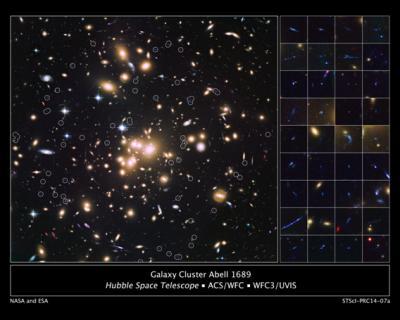RIVERSIDE, Calif. — A team of scientists led by astronomers at the University of California, Riverside has used NASA's Hubble Space Telescope to uncover the long-suspected underlying population of galaxies that produced the bulk of new stars during the universe's early years.
The galaxies are the smallest, faintest, and most numerous galaxies ever seen in the remote universe, and were captured by Hubble deep exposures taken in ultraviolet light.
Study results appear in the Jan. 10 issue of The Astrophysical Journal, and will be presented today (Jan. 7) at the 223rd meeting of the American Astronomical Society in Washington DC.
The 58 young, diminutive galaxies spied by Hubble were photographed as they appeared more than 10 billion years ago, during the heyday of star birth. The newly discovered galaxies are 100 times more numerous than their more massive cousins. But they are 100 times fainter than galaxies detected in previous deep-field surveys of the early universe.
These galaxies would normally be too faint for Hubble to see. But the astronomers were able to detect them by teaming Hubble with a natural zoom lens in space, produced by the gravity of Abell 1689, a giant foreground galaxy cluster. The cluster is so massive that it magnifies the light from faraway galaxies behind it due to a phenomenon called gravitational lensing, where the curvature of space acts like a giant funhouse mirror to stretch and brighten distant objects.
"There's always been a concern that we've only found the brightest of the distant galaxies," said study leader Brian Siana, an assistant professor of physics and astronomy. "The bright galaxies, however, represent the tip of the iceberg. We believe most of the stars forming in the early universe are occurring in galaxies we normally can't see at all. Now we have found those 'unseen' galaxies, and we're really confident that we're seeing the rest of the iceberg."
Siana's team believes it has completed the census of galaxies at an epoch when the universe was roughly 3.4 billion years old. If this sample of galaxies is representative of the entire population at this early time, then the majority of new stars formed in these small galaxies.
"Though these galaxies are very faint, their increased numbers means that they account for the majority of star formation during this epoch," said team member Anahita Alavi, a Ph.D. graduate student in Siana's lab, and the first author of the research paper.

An image taken with the Hubble Space Telescope of Abell 1689, a massive cluster of galaxies whose gravitational pull is so strong that it bends light, acting like a lens. This "gravitational lens" magnifies galaxies behind the cluster, making them appear far brighter than they would if the foreground cluster of galaxies were not there. The galaxies discovered in this study (circled) are magnified by factors of 3-100 and are fainter than any galaxies seen at this distance before. These previously unseen distant galaxies are so numerous that they are likely producing the majority of stars formed in the early universe. Zoomed in images of many of the galaxies are shown on the right. The galaxies are very compact (diameters 1/30th-1/100th the size of our own Milky Way galaxy) and very blue, meaning they have recently formed many new stars.
(Photo Credit: NASA and ESA; Space Telescope Science Institute.)
Siana explained that uncovering these galaxies also helps bolster claims that hot stars in small galaxies pumped out enough radiation to ionize hydrogen by stripping off electrons. This process, called "reionization," occurred about 13 billion years ago, within the first billion years after the Big Bang. Reionization made the universe transparent to light, allowing astronomers to look far back into time.
"Although the galaxies in our sample existed a few billion years after reionization, it's presumed that galaxies like these, or possibly some of these galaxies, did play a big role in reionization," Siana said.
The early galaxies do not look like the majestic spiral and elliptical galaxies seen in our galactic neighborhood.
"The gravitational lensing stretches out the apparent shape of the distant galaxies, resolving them," Alavi said. "Without the lensing, some of the galaxies would be just point sources to Hubble. We now have an idea about their sizes that previously were impossible to measure because the galaxies were unresolved."
The Hubble analysis shows the galaxies are small, irregularly shaped objects measuring just a few thousand light-years across.
"Even when fully mature, these galaxies will be about one-tenth to one-hundredth the mass of our Milky Way," Siana said. "Because they are undergoing a firestorm of star birth, their light is dominated by the ultraviolet glow of fledgling stars."
The research team used Hubble's Wide Field Camera 3 to search for faint, star-forming galaxies in ultraviolet light, a reliable tracer of star birth. The galaxies existed when the universe was undergoing a "baby boom" of star formation, estimated to have peaked between 9 billion and 12 billion years ago.
This strategy of surveying large numbers of background galaxies with deep observations of lensing clusters is being used in a new three-year Hubble survey, called the Frontier Fields. Hubble astronomers are using Hubble to exploit the magnification powers of six massive galaxy clusters in a hunt for small galaxies that existed more than 12 billion to 13 billion years ago.
The galaxies discovered in these lensing surveys will be prime targets for the James Webb Space Telescope, an infrared observatory scheduled to launch in 2018. Through spectroscopy, Webb will divide the light from each galaxy into its constituent colors, yielding information on the star birth and chemical content of each galaxy.